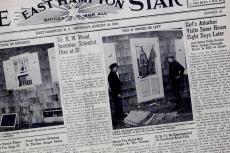As part of an effort to create more affordable housing, the director of East Hampton Town’s Planning Department issued a slew of recommendations to the town board on Tuesday aimed at expanding incentives for residents to offer affordable accessory apartments for rent.
Detached affordable accessory structures were introduced to the town code in 2016, allowing such housing on parcels of at least 40,000 square feet. That requirement was later reduced to 30,000 square feet, increasing the pool of eligible properties and, it was hoped, encouraging more property owners to participate. Affordable attached accessory apartments are allowed within a residence on parcels of at least 20,000 square feet.
The maximum monthly rent charged for such housing may not exceed standards set forth in the code, at present 110 percent of the fair market rent for existing housing as set by the federal Department of Housing and Urban Development’s Nassau-Suffolk Metro Fair Market Housing Area. That figure is now $1,865.
The 2016 amendment to the town code allowed for a maximum of 20 such units in each school district, 100 in all. But apart from those seeking to house a family member, very few have taken advantage: To date, just 43 such units exist, and only East Hampton has reached its limit of 20. Fifteen are in Springs, six in Montauk, and two in Amagansett. Wainscott has no such units.
“We didn’t have the dials adjusted correctly,” said Jeremy Samuelson, the planning director, “so over half of the units have gone unused. The current program works for family members, but we know the need is much greater.”
Mr. Samuelson recited now-familiar statistics as to the scarcity of affordable housing in the town. Of some 600 new housing units constructed between 2010 and 2020, around 60 percent are used seasonally. Less than 3 percent of the town’s housing stock is deemed affordable, and a quarter of town households have “severe housing problems,” defined as spending 50 percent or more of income on housing. A third of mortgage holders and 70 percent of renters spend more than 35 percent of their income on housing. There are fewer young adults and families as a percentage of the town’s population, which skews older than the New York State and national averages.
Income opportunities, the application and annual renewal process, and program and code requirements have proven impediments to the program, Mr. Samuelson told the board. “One broad observation is, the numbers don’t work for a homeowner,” he said. Property owners “are not sufficiently incentivized to go through this program,” citing the cost of building an apartment versus the return in the form of rental income, which is capped. He proposed increasing the maximum rent allowed from 110 to 130 percent of the fair market rent, which would put the maximum monthly rent at $2,204.
Mr. Samuelson proposed raising the limit of units per school district from 20 to 40, and further reducing the minimum lot size for properties with detached accessory units to a half-acre. He also proposed an increase in the number of bedrooms allowed from one to two, an increase in the maximum size of detached apartments from 600 to 900 square feet, and allowing attached apartments to be as much as 50 percent of the gross floor area of the principal dwelling.
He suggested eliminating existing restrictions on such housing in harbor protection overlay and affordable housing overlay districts, simplifying the process by which a property owner can live in an accessory unit and rent the principal dwelling as an affordable residence, and eliminating a year-round occupancy requirement for the renter and property owner, which he acknowledged would be “a pretty significant change.”
In an aging population in particular, many have the means to spend the winter months elsewhere, for example. “They would not be eligible at this point,” he said. “If they left on an extended vacation, they would be in violation of code as written now.”
As an example of a renter who would benefit from eliminating the year-round residency requirement, he described a seasonal worker, a chef who arrives at the end of March and departs in November. “He’s technically not eligible to rent, yet he’s been here 20 years.” The principal priority, he said, should be rental units that can be certified as affordable, and not whether a renter is in the town in January and February.
The current limit of two people per affordable unit should be reconsidered, he said. Under the code now, if a couple has a child it renders them homeless, he said. The annual renewal process for those offering affordable accessory apartments should also be simplified, he said. At present, an application must be completed in full every year, even for renewals.
Supervisor Peter Van Scoyoc said he has firsthand knowledge that “many of these proposed changes will be welcomed. . . . All of these are ways to address those obstacles.”
The discussion will continue, he said, eventually leading to a public hearing on proposed code amendments.




